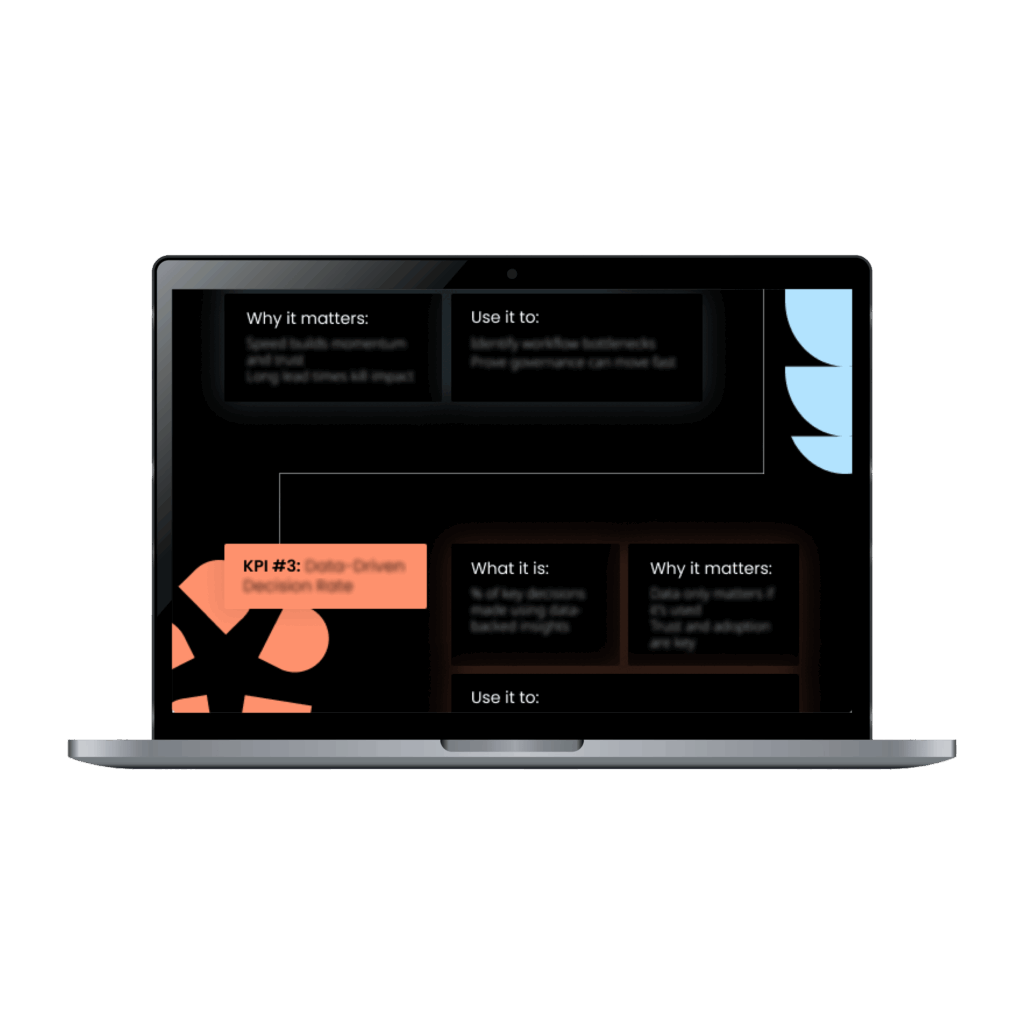
5 key considerations your teams need when building an AI governance framework
With great power comes even greater risk.
AI is being adopted at a blistering scale and pace. However, the unintended downside is that it’s moving faster than policy, tooling, or training can keep up.
It’s time for a dedicated AI governance framework. One that’s squarely rooted in your business realities, expands with your ambitions, and sustains AI with confidence, not chaos.
But beyond avoiding risk, it’s about building the structure, accountability, and context that help AI deliver real value and profitability.
Here are the 7 key considerations for building an AI governance framework that’s practical, resilient, and ready for what’s next.
TL;DR summary
AI has moved from experimentation to enterprise-wide transformation, making AI governance a critical driver of competitive advantage, ethical safety, and regulatory compliance.
In 2026, organizations must align with rapidly evolving global regulations (EU AI Act Phase II, U.S. AI Accountability rules, ISO/IEC 42001:2025), improve transparency across the AI lifecycle, and build robust cross-functional governance structures.
This article presents a comprehensive framework that blends principles, lifecycle controls, and cultural enablers—and explains how DataGalaxy acts as the foundational Data & AI Product Governance Platform to operationalize it at scale.
What is AI governance?
AI governance refers to the policies, processes, accountability structures, and technical safeguards that ensure AI is developed, deployed, and monitored responsibly.
In 2026, AI governance must explicitly cover:
Core governance entities
- AI Products: Production-grade AI systems with defined business purposes, owners, and lifecycle stages.
- Model Cards & System Cards: Standardized documentation required under modern regulations.
- Data Products: Reusable, governed datasets used to train or feed AI systems.
- Governance Roles: AI Product Owners, Data Stewards, AI Risk Officers, Compliance Officers, domain SMEs.
- Technical Controls: Model explainability, fairness testing, lineage tracing, drift detection, and policy automation.
Key governance themes
- Transparency & Explainability
Required by most regulations and essential for user trust. - Fairness & Non-discrimination
Explicit assessments of bias across demographic or risk-sensitive groups. - Accountability & Ownership
Clear designation of who builds, approves, deploys, monitors, and retires each AI asset. - Security & Privacy
Secure access, protected inference pipelines, and privacy-preserving computation. - Continuous Risk Management
Not static audits—continuous measurement, alerting, and escalation.
Why AI governance is more critical than ever
By 2026, three forces make AI governance unavoidable:
1. Global regulations are fully active
- EU AI Act — High-Risk Systems Provisions (2026)
- U.S. AI Accountability Act of 2025
- China’s Algorithmic Recommendation Law
- ISO/IEC 42001 AI Management System certification requirements
These require documentation, monitoring, explainability, incident reporting, and human oversight.
2. Complex model types introduce new risks
- Multi-agent systems
- Autonomous decision engines
- Generative AI with retrieval-augmented pipelines
- Fine-tuned LLMs with dynamic prompt behaviors
3. Organizations need scalable trust
Enterprises now deploy hundreds of AI products across federated teams. Governance must scale without slowing innovation.
AI governance vs. data governance (2026 view)
While intertwined, they have distinct scopes:
| Data Governance | AI Governance |
|---|---|
| Ensures data is accurate, high-quality, secure, and well-documented. | Ensures AI systems behave safely, ethically, and transparently. |
| Establishes lineage & metadata for datasets. | Establishes lineage & metadata for models and decision processes. |
| Controls access to sensitive data. | Controls how models use that data and how their outputs impact people. |
In 2026, AI governance extends data governance. You cannot govern AI without governing the data that fuels it, but AI introduces additional lifecycle complexity, risk domains, and oversight expectations.
Designing data & AI products that deliver business value
To truly derive value from AI, it’s not enough to just have the technology.
Data professionals today also need a clear strategy, reasonable rules for managing data, and a focus on building useful data products.
Read the free white paper
The 5 core principles of AI governance
1. Transparency & traceability
Models must be fully explainable, traceable, and defensible—especially generative systems.
2. Fairness & equity
Organizations must conduct bias testing, demographic fairness analysis, and scenario-based simulations.
3. Accountability & human oversight
Every AI product must have:
- A responsible owner
- A lifecycle steward
- Built-in human oversight checkpoints
4. Privacy & security
Modern standards expect:
- Data minimization
- Secure model hosting
- Governance for inference risks
- Synthetic data controls
5. Continuous risk management
Dynamic dashboards, real-time alerts, incident logging, and automated mitigation workflows.
The 2026 AI governance framework: A five-step pathway
Let’s dive into the 5 key considerations for building an AI governance framework that’s ready for what’s happening now and built to adapt to what’s coming next.
1. Define your scope
Before you build policies or choose tools, get clear on your top priorities and what’s realistic to achieve right now.
There’s no universal playbook. A global bank’s needs will differ wildly from a midsize SaaS startup. That’s why your first move isn’t to act, but to define your scope.
- Map all AI and data products across business units.
- Align governance with strategic goals (e.g., personalization, fraud detection, operational efficiencies).
- Conduct an AI maturity assessment: people, processes, tools, policies.
Start by asking:
- Which AI models are already in use?
- Which business units are deploying or experimenting with AI?
- What data types (personal, financial, regulated) do those models touch?
- Who’s accountable for outcomes? And who should be?
Determine what your AI framework needs to cover today, and plan how it can scale for tomorrow. Don’t over-engineer – progress beats perfection.
2. Assign roles that drive accountability
You can’t govern what no one owns. AI introduces new risks, workflows, and ethical dilemmas, so your framework needs clearly defined roles to address them.
Create organization-wide AI policies aligned to EU AI Act, NIST AI RMF, and ISO standards.
Define formal governance roles:
- AI Product Owner
- Data Product Owner
- AI Risk Officer
- Ethics or Compliance Officer
- Federated Domain Stewards
Establish approval workflows for new use cases for the following roles:
- Model owners: The people responsible for performance and upkeep across the entire data lifecycle, from design to deployment to retirement. This includes retraining schedules, monitoring for drift, and ensuring inputs stay relevant as the business matures.
- Risk officers or AI ethics leads: These roles serve as the conscience of your AI program. They focus on fairness, compliance, and identifying unintended consequences before they become regulatory or reputational problems.
- Business stakeholders: These people are the “Why?” behind your models. Involve them in use case approvals. Align outputs to KPIs they actually care about, like conversion rates, cost reduction, or customer satisfaction. Make sure the model delivers a measurable business impact.
Don’t give a pass to the rest of the org chart – everyone should understand their specific role and responsibility for upholding AI and data governance.
3. Lay a data governance foundation and catalog assets first
You can’t trust AI if you can’t trust your data.
If inputs are flawed, biased, or incomplete, your models will collapse under the weight of their faulty assumptions. That’s why strong data governance is the ground floor of responsible AI.
Before you launch an AI initiative, make sure the basics are in place:
- Ownership: Who’s responsible for each dataset and its quality?
- Lineage: Can you trace where the data came from, how it was transformed, and what it powers?
- Quality rules: Are your inputs accurate, complete, and timely?
- Access controls: Are sensitive or regulated data assets adequately protected?
Get your data house in order before you invite AI in. A compliant 2026 catalog includes:
- Model cards
- Training datasets
- Evaluation metrics
- Fairness assessments
- Lineage from data → features → models → outputs
- Owners, SLAs, and lifecycle stage

The 3 KPIs for driving real data governance value
KPIs only matter if you track them. Move from governance in theory to governance that delivers.
Download the free guide4. Prepare for stiff regulations & risk control
AI regulation is no longer hypothetical. It’s here and it’s intensifying.
From the EU AI Act to a growing patchwork of U.S. state-level laws, governments are moving fast to define how AI can (and can’t) be used. These rules are affecting everything from how you categorize your models to how you document their behavior.
Your governance framework should make it easy to:
- Identify high-risk AI systems that require special controls
- Document model intent, design decisions, training data, and monitoring practices
- Prove fairness, transparency, and explainability before someone asks
For example, a health insurer utilizes AI to flag claims for review to identify potential fraud. Because the model directly influences access to care and financial outcomes, it’s high-risk by definition.
Strong AI governance must classify the model appropriately, record how decisions are made and what informs them before it ever impacts a single claim.
Pre-deployment
- Bias, fairness, & robustness testing
- Privacy assessments
- Explainability validation
Deployment
- Versioning and reproducibility tracking
- Deployment logs & approval trails
Post-deployment
- Drift detection
- Incident reporting
- Policy adherence monitoring
- Human oversight feedback
5. Build a culture of responsible & literate AI use
Policies don’t shape behavior. People do.
If your teams don’t understand, believe in, or are unprepared to follow your governance program, they won’t. Promoting a culture of responsible AI use and data literacy to support it is just as important as the rules themselves.
Start with education
Train teams on the ethical, operational, and strategic implications of AI. From model bias to data privacy, build the baseline data and AI literacy they need to make informed, responsible decisions.
Champion transparency
Invite and encourage open dialogue when models behave in unexpected ways. Create space to challenge assumptions. Make it safe to ask hard questions about outcomes, risks, and trade-offs.
Reward responsible behavior
Recognize the people who raise concerns, improve documentation, or drive process improvements. These are your governance champions.
The goal isn’t perfection, it’s accountability. Build a culture that understands AI’s power and has the fluency to use it wisely.
- AI literacy programs for all employees
- KPI dashboards for trust, drift, fairness, and audit performance
- Quarterly governance reviews
- Continuous improvement loops
How AI governance creates business value
- Predictable and compliant AI operations across geographies
- Reduced legal and ethical risks
- Greater customer and stakeholder trust
- Accelerated innovation, not slower
- Optimized infrastructure and model reuse
- Direct linkage between AI efforts and measurable business impact
Driving outcomes with a value-driven data & AI portfolio
DataGalaxy’s demand management portal helps surface new initiatives by making it easy to explore, contribute, and build on ideas.
With guided templates, every use case is captured in a structured, review-ready format that supports fast, informed prioritization.
Discover DataGalaxyWhy DataGalaxy is the 2026 leader in data & AI product governance
DataGalaxy provides the industry’s only fully integrated Data & AI Product Governance Platform, enabling:
1. A unified repository for all data & AI products
Catalog all entities—models, datasets, pipelines, metrics, policies—in a single system of record.
2. Policy automation & compliance monitoring
Automated checks for drift, bias, lineage gaps, metadata completeness, and EU AI Act traceability.
3. Value-based governance
Connect every AI or data product to defined KPIs, ROI measures, business ownership, and adoption metrics.
4. Federated collaboration at scale
Support for cross-domain stewardship, approval workflows, and multi-team collaboration.
5. Security-first architecture with explainability tools
Secure, EU-compliant infrastructure with explainable AI and full decision traceability.
AI governance: your framework for what’s next
AI offers great power but poses even greater risks to those unprepared to wield it.
Keep these 5 key considerations at the top of mind when building an AI governance foundation for trust, scalability, and impact. A foundation that lets your teams innovate with clarity, meet compliance with confidence, and keep risk on the sidelines.
Start by getting clear on what your organization needs today and what you’re ready and able to build.
FAQ
- What is AI governance?
-
AI governance is the framework of policies, practices, and regulations that guide the responsible development and use of artificial intelligence. It ensures ethical compliance, data transparency, risk management, and accountability—critical for organizations seeking to scale AI securely and align with evolving regulatory standards.
- What are the key principles of AI governance?
-
Key principles of AI governance include transparency, accountability, fairness, privacy, and security. These principles guide ethical AI development and use, ensuring models are explainable, unbiased, and compliant with regulations. Embedding these pillars strengthens trust, reduces risk, and supports sustainable, value-driven AI strategies aligned with organizational goals and global standards.
- How can organizations implement AI governance?
-
Organizations implement AI governance by developing comprehensive frameworks that encompass policies, ethical guidelines, and compliance strategies. This includes establishing AI ethics committees, conducting regular audits, ensuring data quality, and aligning AI initiatives with legal and societal standards. Such measures help manage risks and ensure that AI systems operate in a manner consistent with organizational values and public expectations.
- How is value governance different than data governance?
-
Value governance focuses on maximizing business outcomes from data initiatives, ensuring investments align with strategic goals and deliver ROI. Data governance, on the other hand, centers on managing data quality, security, and compliance. While data governance builds trusted data foundations, value governance ensures those efforts translate into measurable business impact.
- How do I implement data governance?
-
To implement data governance, start by defining clear goals and scope. Assign roles like data owners and stewards, and create policies for access, privacy, and quality. Use tools like data catalogs and metadata platforms to automate enforcement, track lineage, and ensure visibility and control across your data assets.
At a glance
- AI governance aligns AI initiatives with business goals while managing risk through clear scope, accountability, and compliance.
- Effective governance depends on strong data management, transparent decision-making, and proactive regulatory readiness.
- Building a responsible AI culture ensures ethical, explainable, and trustworthy AI adoption across the organization.

